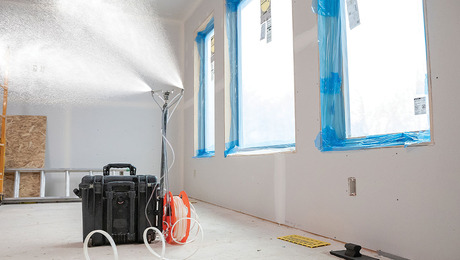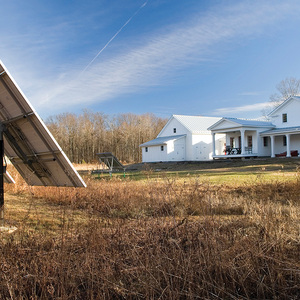Does metal conduit provide grounding?
My HVAC contractor says that properly installed metal conduit does not provide adeqaute grounding. He wants a wire ground pulled the length of the conduit.
It seems he wants this to be insulated green wire. If this is the case it seems this insulated wire would need to be connected to each part of the metal conduit run. Else, it could be argued that each piece not connected to the ground wire is not adequately grounded.
Or perhaps what he really wants is bare copper ground wire pulled along with the insulated electical wires.
Thoughts?



















Replies
Why is your HVAC contractor dictating your electrical requirements? Let him tell the electrician what size service he needs at the equipment, and let the electrician do his job and properly provide it.
Typically, you don't rely on the conduit for grounding the circuit, and you pull an insulated green wire for the ground. The conduit will take care of itself.
Bob
I use an electician whose rates I can afford and who is there on schedule. That is me.
I wonder how cheap that is going to be when the house burns down or the kid or wife gets electrocuted through the faucet or baseboard heat.
Regular or Extra Crispy?
-zen
Me thinks the HVAC contratcor is correct.
Rigid (threaded) conduit stands a better chance of providing continuity than the EMT (thin wall) conduit.
Either way I would still pull the green ground conductor; if you do not have any green wire, I do not think there is a problem with re-coding whatever color you do have with green tape at both visible ends. For example, if I were to open a box and find a black wire wrapped with green tape, I would assume that I was looking at a ground conductor - a meter would tell me if I was correct.
The metallic boxes at both ends of the conduit run should be grounded and thus at least the first section of EMT leaving those boxes.
Jim
"I do not think there is a problem with re-coding whatever color you do have with green tape at both visible ends. For example, if I were to open a box and find a black wire wrapped with green tape, I would assume that I was looking at a ground conductor - a meter would tell me if I was correct"
All true, but it would violate the NEC, which requires small equipment grounding conductors to be bare or a "continuous" green. (You can re-identify #6 AWG or larger).
My vote is with the majority: pull the ground wire, and don't trust the metal conduit for a ground path (even though if done correctly it would meet NEC requirements).
Thanks, I never knew that - I thought you could recode any size.
Jim
Edit: Does that rule aply to all conductors? or just grounding conductors? The reason I ask is because I was taught it was good form to recode the white conductor in a Romex switch leg to black using a tape wrap to help avoid future confusion.
Edited 5/27/2005 9:01 am ET by JTC1
In general you can re-identify conductors, and you're right, it is frequently a good practise. But the code is picky about EGC's. They must be either bare CU or green insulation all the way (NEC 250-119 in the 1999 code)
Here in the Chicago area, all wiring must be in conduit. In the 20+ years I've been a contractor, I've never had an electrician pull a separate ground wire through the conduit, nor does code require it.
Check your local code.
NEC (1999) 250-118
"Types of Equipment Grounding Conductors -
The equipment groundign conductor run with or ENCLOSING the circuit conductors shall be one or MORE or a aCOMBINATION of the following.
(1) (copper wire, solid or stranded, insulated or bare)
(2) Rigid metal conduit
(3) Intermediated metal conduit
(4) ELECTRICAL METALLIC TUBING.
..."
Now flexible metallic conduit and liquidtite metallic has a number of special conditions.
But EMT is list for use as the EGC.
That said many people fell that it is better to all inlcude a ground wire because of the posibility that it the conduit is run properly that the connections can come lose.
But the code does not require it. However, there might be some local admendments that do require a separate ground wire.
Properly installed metal conduit should provide adequate grounding - if it's "properly installed".
Since the majority of the conduit is hidden, it takes a large leap of faith to assume that it actually provides a good ground path. If there's any plastic conduit, you've lost the ground path.
Thanks all.
The conduit will hang on the wall of the garage, clearly visible but unreachable. I learned long ago to make those coinduit connections TIGHT.
I have done all my electrical work basically under the Chicago code. Never heard of a separate ground wire before. Never had an inspector suggest one.
I would like to share iwth you one item of electrical work done in this house by a 'professional'. Two thru-the-wall air conditioners requiring 220 were installed. The 'professional' electrician used 12 gage Romex 2 wire to make the hook up. The copper ground wire was the return.
That guy did not stay around to see how we were cooked in a solid rain.
I, at least, was dumb enough to ask.
Two thru-the-wall air conditioners requiring 220 were installed. The 'professional' electrician used 12 gage Romex 2 wire to make the hook up.
'sounds OK to me. just tape the ends of the white conductors with red tape to indicate that they aren't "neutral" wires in this application, if your a stickler for code.
240V window air conditioners are 240V devices only, not 240/120V devices. Snce they don't need 120V, they don't need a neutral. Just 2 hots, and a grounding conductor.
"The copper ground wire was the return." This statement is where his confusion lies, I think?
I was scratching my head on this one too, I think he means because there was no neutral ran that he thought there was a problem. I reread that post twice and am still confused.
Edited 5/27/2005 2:19 pm ET by TROYLS1
While I am also confused by the "return" comment it is still agaisnt code.He indicated that he is in Chicago area and code requires CONDUIT, period.
If there's any plastic conduit, you've lost the ground path
And that would be a code violation, unless provisions were made for ground path integrity.
It seems to me that alot of code compliance issues are hidden from view and require something of a "leap of faith". That's what inspections are for.
I use EMT for grounding all the time. EMT is supposed to be properly secured and/or protected such that "bumping" doesn't affect it. I only put a grounding wire in flex.
I don't see the advantage of green over bare, either. The conduit, and anything else the wire should come in contact with are all supposed to be at ground potential. You only need to insulate a grounding conductor if its for an "isolated ground" application. Alot of times I'll just take a length of white or black and strip the insulation off, and use that for the grounding conductor. Although if a buy a roll of wire to use as a grounding wire, alot of time I get the green because paradoxily, it is cheaper than bare.
I have seen several instances where the conduit gets bumped losing its connection. Bets to have a separate ground wire.
Joe Phillips
Plastics pay the bills, Woodworking keeps me sane!
Conduit grounds are legal by the NEC. Of course the AHJ has the right, as the NEC itself allows, to make the final call on this.
Electrically a conduit ground is usually better that a ground wire. Steel is not as good a conductor as either copper or aluminum but it more than makes up for this by providing a much larger cross-section.
Problem is that conduits, by design, take physical and chemical abuse. So the electrical advantage often, given time and wear, disappears leaving, given a lack of a dedicated ground conductor, a greatly deteriorated ground path or no ground at all.
Galvanized steel, particularly more lightly coated conduits like EMT, eventually, given some moisture and environmental contamination, loses the protective zinc. Once the zinc is gone the steel rusts and falls apart. Tight connections, again particularly EMT types, loosen with vibration and heat cycling. Teenagers doing pull-ups on exposed conduit runs doesn't help either.
IMO installing a dedicated ground wire is cheap insurance. Part of the benefit is that a pulled ground wire doesn't replace the conduit ground. Each acts as a redundant ground path for the other. Should the conduits ground path corrode through or a connection vibrate free the ground wire saves the day. If the pulled ground should be compromised, rare but not impossible because it is protected by the conduit, the conduit keeps things safe.
Of course if the conduit were entirely rigid steel, heavy wall, conduit that is threaded together. That has a heavier coating of zinc and a lot of steel protecting itself and the contained conductors the conduit ground sounds pretty good. Of course, in residential construction, there isn't much rigid steel, RMC, conduit being run. It is quite expensive to run. Expensive to buy, heavy and bulky to transport, tiring to install, it demands more highly skilled labor and expensive specialized tools to work with. RMC is overkill for most residential situations.
IMO if your running RMC and there is no reason to believe that the environment is corrosive pulling a ground wire is a judgement call. I do but can't say too much to those who don't. If your running EMT, thinwall, I think running a dedicated ground wire is smart. Not running one is, IMHO, short sighted and an invitation to an accident ten or twenty years down the line.
A pretty big panalty for such a small savings in time and materials.
I once got a severe shock from conduit at work. This was on a loading dock. The conduit had gotten hit by a forklift which pulled it apart, but also pulled the wires causing the one end of the conduit to be hot. I was using the pipe cutting bandsaw (which also became hot) to cut a metal bar and came into contact with a grounded conduit at the same time. Very bad deal. I yanked out the bandsaw cord and tagged it and the conduit, then went to complain to maintenance. Electrician says you cant get shocked on conduit cause its always grounded. I told him you sure can because I did just a couple minutes ago. He said the bandsaw must be bad, and he would check it out. He ended getting a bit of a zap himself because he touched both conduits at the same time when he was messing around. Showed me what happened later, the hot wire got cut where it got pulled out of the box and it nicked at the connector.